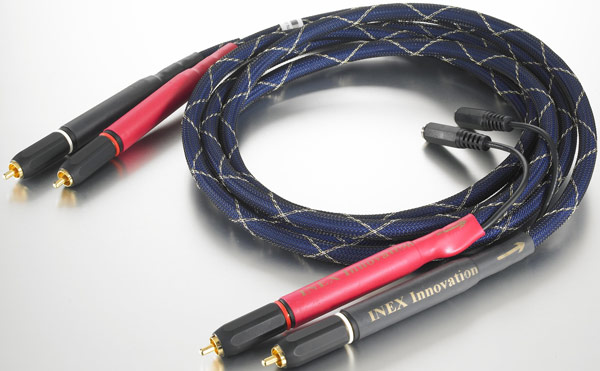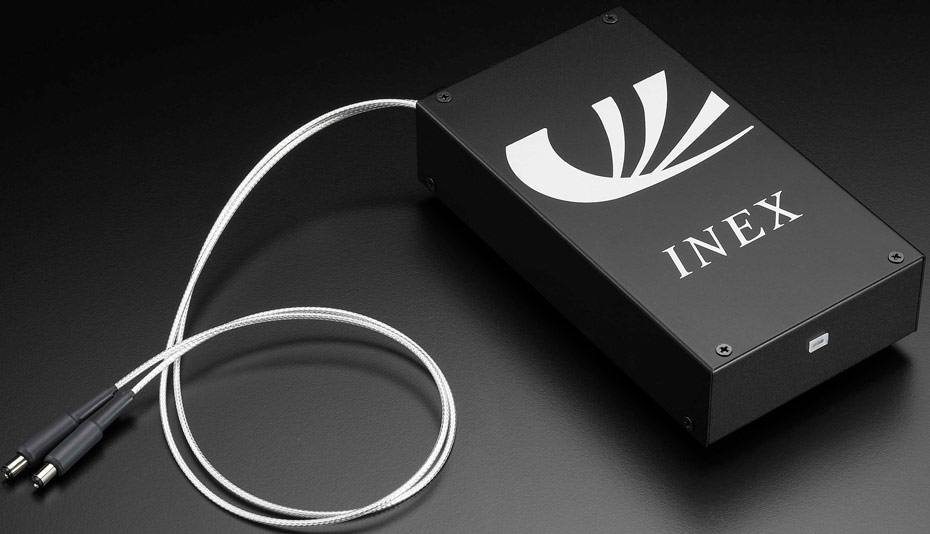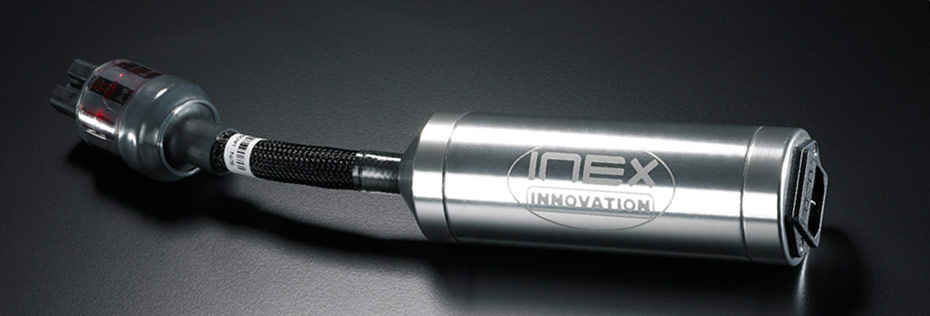Beam Me Up, Scotty!
The Photon Cables is where things get a bit confusing, though not perhaps as wild as a Star Trek transporter. Thankfully, the jackets of the interconnects, amplifier cables, and digital cables all are color coded! Due to the glass filaments in them they do not flex as much as thinner copper cables; one must take care not to force them too much or kink them! On their ends they all have power leads which need to be fed by power from an outlet; no power – no signal, as there will be no light sent through them.
The preamp has no cable power ports. In order to use the Photon Cables (the fiber optic interconnects, amplifier cables and digital cables; there are no Photon speaker cables yet) one must supply power to them. Each Photon Cable has a power lead at each end in which resides a Laser Analogue Module (LAM), to which must be fed DC power. An i-Pure DC Power Supply is used to get the beam started at the preamp end, but at the amp end there is port on the back of the amp into which the power lead can be plugged. The point is that both ends of Photon Cables must be powered, either with an i-Pure DC Power Supply or by the amp.
The INEX cabling can be used with other brands of components, which I tried, including the VAC Signature MkII Preamplifier. When using the Photon Cable system in such a fashion one must use the i-Pure power supplies entirely. Each one of these, in turn must be powered at the wall or from one’s power conditioning system. Consequently, the Photon Cable scheme is not simply a matter of slapping cables into a rig, but of coordinating the fiber optic interconnects, the i-Pure power supplies, and positioning i-Pure DC Power Supplies and all attending power cables.
This can be a bit of a challenge, as it is possible to improve the performance of the Photon Cable Interconnects by doubling the i-Pure units used with them! I was not initially satisfied with the performance of the interconnects, and in discussion with Kevin learned that double power leads are available on the upscale line of Photon Cables! So, then, the double leads of the four i-Pure power supplies were doing double duty powering two leads on each end of interconnects! I was running out of wall outlets, and I have had eight of them immediately available for the system. I had to press into service the Wireworld Matrix Power Cord Extender power bar for all the i-Pure units in use. There was a marked improvement in the performance of the cables with double leads.
Optics and Sonics
So, what does a rig with fiber optic interconnects and cabling sound like? My initial impression was that I loved the detail but felt that the cabling was nearly “prismatic”, chopping up the frequencies to pieces versus rendering an organic whole. The music seemed tilted upward in its weighting, emphasizing midrange and treble as opposed to bass. This was the first set of cables with one power lead.
I wondered if some of this analytical nature to the sound could be due to the use of the i-Pure AC Filter Tubes, the silver colored cylindrical power filter devices to be used with each of the components. The reason the thought occurred to me is that in every system I have assessed power filtration or power conditioning devices regardless of their cost, they have sharpened the sound of the system, but at the cost of suppleness and smoothness. This I chalk up to the addition of another component in the signal path. Such devices are supposed to clearly enhance the sound, but I have found with all of them a tradeoff; dynamics for clarity. Consequently, I removed the i-Pure AC Filter Tubes, and the sound immediately took on a warmer, less frequency-fractured nature. As with so many power conditioning devices, they spent the better part of the review period sitting off to one side, as they did not absolutely enhance the performance of the components.
However, the i-Pure AC Filters were quite handy to quell an audible hum emanating from the amps. When I commented about the transformer noise of the amps I was told, “You should think of this in reverse. Because of our filter technology, you’re able to hear the difference and emission of transformer noise. For other amps without the benefit of our technology to compare with, you will not nearly notice this as much. We’ve developed the filtering technology to improve the sound and it is advisable to use it.” I think this means, “Our amp’s photon technology exposes more noise, so use the filtering technology.”
I chose not to. Instead, I decided to experiment. This is where things get dangerous in my reviews; I tend to put devices in places where it’s not suggested. Note I did not say I tend to put things where it’s not recommended. There is a big difference. I found the amps to be absolutely quieter with the i-Pure AC Filters, as advertised. However, as mentioned above the music was more brittle sounding than I was willing to accept. Consequently, I pulled the i-Pure filters off the components to regain clarity as the transformer hum was drowned out when the music level increased even modestly, and put them on the i-Pure AC Power Supplies!
You need to visualize the oddity of this maneuver; rather lightweight fiber optic cables plugged into a black DC power supply about double the size of a pack of cigarettes, from which protruded an even larger cylinder power filtration device! The weight of the i-Pure AC Filter plugged into the smaller i-Pure DC Power Supply nearly pulled it off the shelving as the now much heavier power cable was pulling heavily downward on this little box! I was able to find a balancing point at the back of the power supply; it sat upward at the front, looking like a funny car popping a wheelie.
I wondered if the filters would enhance the cables’ performance more so than the components; they did so dramatically, in my estimation. The Photon Cables became much more robust, so much so that I did not use them without the i-Pure AC Filters the remainder of the time with the system. It was odd, as two variables one might think would not influence the light transmission of the Photon Cables both had profound influence upon them. The first was the addition of an extra power lead, and the second was the addition of the i-Pure AC Filters to the i-Pure DC Power Supplies. In a pronounced fashion these both upgraded the performance of the entire system in a “powerful” way.
Now there was some genuine warmth entering the system’s sound. Without the extra management of the cabling their character was best described as lightweight, quick, and highly detailed. The system lay in the territory of a highly resolving but lacking in warmth. Persons who enjoy tubed equipment with analogue sources would likely not enjoy the sound much. On the other hand, those who like high power, highly precise sound would be very enthusiastic. The Photon Amps sounded more forceful than their 80wpc rating into 8 Ohms and 120 wpc into 4 Ohms. Hearing Fourplay’s quartet on their disc Best of Fourplay, I assessed the sound quality as extremely precise, detailed without harshness. Cymbals, bells, shakers and the like had never seemed so large, so pronounced, yet not disruptive. Piano was rendered with a high degree of intimacy, as I could nearly sense the transfer of energy from the fingers to the keys.
One of the strongest positive attributes of the INEX system was a pronounced sense of excitement, a nearly palpable energy – should we be surprised – flowing through the rig. From the smack of a drumstick to the breath vibrating a reed on a saxophone, the urgency of something happening takes hold of the listener. Perhaps the black backgrounds associated with the light transmission are to credit for much of this energetic performance. A prime example of this super-clean performance is heard on “Play and Pleasure”, at approximately 2:40 into the piece, when a subtle melding of electric bass and voice is noticed. Many systems would render it as an effect, or perhaps an artifact of the bass line.
Transients seemed to be extremely good with the INEX system. The beginning and ending of individual notes, their “edges”, seem more easily revealed through the Photon Cable system. They seem to materialize into reality versus being pushed from somewhere else. There is no Class A/B “overburden”, or heaviness, heard from the amps, nor any Class D triteness. The experience is something akin to driving an electric car. When the vehicle accelerates the quietness is nearly disturbing; we expect our raucous engine noise to be a part of the driving experience. With the INEX system there is no sluggishness, no veiling from the electronics. Case in point, in the piece “Farewell” by John Doan on the Natural Wonders Sampler 1997, there is so much going on in terms of micro-dynamics – the strings of the guitar, the acoustic envelope of the vibrating air, the echo, room’s reflections, etc. All of these are beautifully presented in the most manicured fashion through the INEX system.
What Kind Of Speaker Cables To Use?
INEX does not make a fiber optic speaker cable, though one can secure complementary cables from Harmonic Technology. INEX developed the Photon Cables for Harmonic Technology, so the two are related. I happened to have worked extensively with Harmonic Technology cabling privately prior to reviewing, and I thought they were a good brand. I have tended to gravitate over the years toward cabling with high numbers of smaller conductors, each wrapped in their own dielectric, with high total gauge – just like Harmonic Technology. These speaker cables should be quite good with the INEX components. Another two suggestions would be Wireworld or Clarity Cable, both of which performed well with the Photon series of components.
Which is better, light, copper or silver?
My immediate answer to the question of which is better, light, copper or silver cabling is, it depends on your preferences. To my ears the INEX Photon system trades some warmth for a brighter, more “shadow-free” sound. What is perhaps part of the character of copper cables, their tonal warmth, is not evident with the Photon Cables. Instruments are not as “weighty” sounding. However just as shining a bright light into recesses reveals previously unseen details, so also Photon Cables reveal interplay between the notes of an instrument and accompanying instruments – a very compelling quality.
The situation is much like comparison between Class A/B amps and Class D amps, with the copper cables like Wireworld’s lower and middle lines likened to Class A/B amps and the Photon Cables represented by Class D amps. There have been well enough established trends in these two classes of amps to make general comparisons. The A/B amps are seen as robust, but are also considered “slower” sounding and not as powerful as, let’s say, a 500wpc Class D amplifier. On the other hand, Class D amps have been described as sounding “white” or technical, yet possessing tremendous power to control speaker transients. Which is better becomes an argument of taste. A copper cable will typically sound more “round” or fuller, but seemingly heavier. The Photon Cables will sound leaner, lighter and vibrant. Those considering components can work with these descriptions to secure components and speakers which will ameliorate these qualities or magnify them.
Bright Future
I believe that INEX Innovation with the Photon series of components and cables have a bright future. These engineers have proven that you can look at the world of high-end two-channel audio differently than the mainstream and develop a product that can compete well. My experience with improvement of the cabling through double power leads and AC filtration applied to the DC power supplies convinces me that there is a lot of potential as of yet untapped, and that similar to Class D amplification every successive generation will prove a nearly “light year” leap in perceived quality. As such the INEX Innovation system is for those who want to be on the cutting edge and want tomorrow’s technology today.(I also have the privilege of auditioning the INEX Innovation products. Watch for a 2nd Review. -CS.)
- ← Previous page
- (Page 2 of 2)




I Love my Inex Preamp ! I use it with my fantastic Audio Power Labs Class A Tube amplifiers the TNT 50 and the TNT833 ! I got 10 of these Faberge Monos !